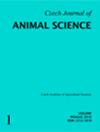The impact of different inclusion levels of whole barley in feed on growth performance, carcass, and gastrointestinal traits of broiler chickens
IF 1.4
4区 农林科学
Q3 AGRICULTURE, DAIRY & ANIMAL SCIENCE
引用次数: 1
Abstract
The aim of the present research was to evaluate the effect of feeding graded levels of whole barley (WB) on broiler chicken growth and carcass performance, gastrointestinal morphology, and function. A total of 800 male Ross 308 broiler chickens (1-day-old) were randomly assigned to four treatment groups with four replicate pens of 50 birds each. Diets differed in their WB dosage: without WB (NO-WB); low WB amount (LOW-WB) dosages: 4% (1–7 days of age), 8% (8–21 days of age), 15% (22–35 days of age); medium WB amount (MEDIUM-WB) dosages: 6% (1–7 days of age), 12% (8–21 days of age), 20% (22–35 days of age); high WB amount (HIGH-WB) dosages: 8% (1–7 days of age) 16% (8–21 days of age), 25% (22–35 days of age). Body weight, average daily gain, and mortality of chickens did not statistically differ between treatments (P > 0.05). The feed conversion ratio was higher in the treatments diluted with WB. There were no differences in ammonia nitrogen concentration except for increased butyrate concentration in the caecum and reduced digesta viscosity in the broiler ileum in groups fed LOW-WB, MEDIUM-WB, and HIGH-WB diets (P < 0.05). The high WB amount in the diets increased Lactobacillus spp. in the ileal contents and improved ileum morphology (P < 0.05). The inclusion of graded levels of WB in the diets had no effect on carcass performance but it seemed to enhance the gastrointestinal tract development.饲料中添加不同水平全大麦对肉鸡生长性能、胴体和胃肠道性状的影响
本试验旨在研究饲喂不同水平全大麦对肉鸡生长、胴体性能、胃肠形态和功能的影响。选取1日龄雄性罗斯308肉鸡800只,随机分为4个处理组,每个处理组设4个重复栏,每个栏50只鸡。不同饲粮中WB的添加量不同:无WB (NO-WB);低WB量(low -WB)剂量:4%(1-7日龄),8%(8-21日龄),15%(22-35日龄);中WB量(medium -WB)用量:6%(1-7日龄)、12%(8-21日龄)、20%(22-35日龄);高WB剂量(high -WB): 8%(1-7日龄)、16%(8-21日龄)、25%(22-35日龄)。各组鸡的体重、平均日增重和死亡率差异无统计学意义(P < 0.05)。WB稀释处理的饲料转化率较高。低体重、中体重和高体重组除盲肠丁酸盐浓度升高、回肠食糜粘度降低外,其余各组氨氮浓度无显著差异(P < 0.05)。饲粮中添加高WB可提高回肠内容物中的乳酸杆菌含量,改善回肠形态(P < 0.05)。饲粮中添加不同水平的白蛋白对胴体性能没有影响,但似乎促进了胃肠道发育。
本文章由计算机程序翻译,如有差异,请以英文原文为准。
求助全文
约1分钟内获得全文
求助全文
来源期刊

Czech Journal of Animal Science
Agriculture, Dairy & Animal Science-奶制品与动物科学
CiteScore
2.40
自引率
16.70%
发文量
44
审稿时长
5 months
期刊介绍:
Original scientific papers and critical reviews covering all areas of genetics and breeding, physiology, reproduction, nutrition and feeds, technology, ethology and economics of cattle, pig, sheep, goat, poultry, fish and other farm animal management. Papers are published in English.
 求助内容:
求助内容: 应助结果提醒方式:
应助结果提醒方式:


